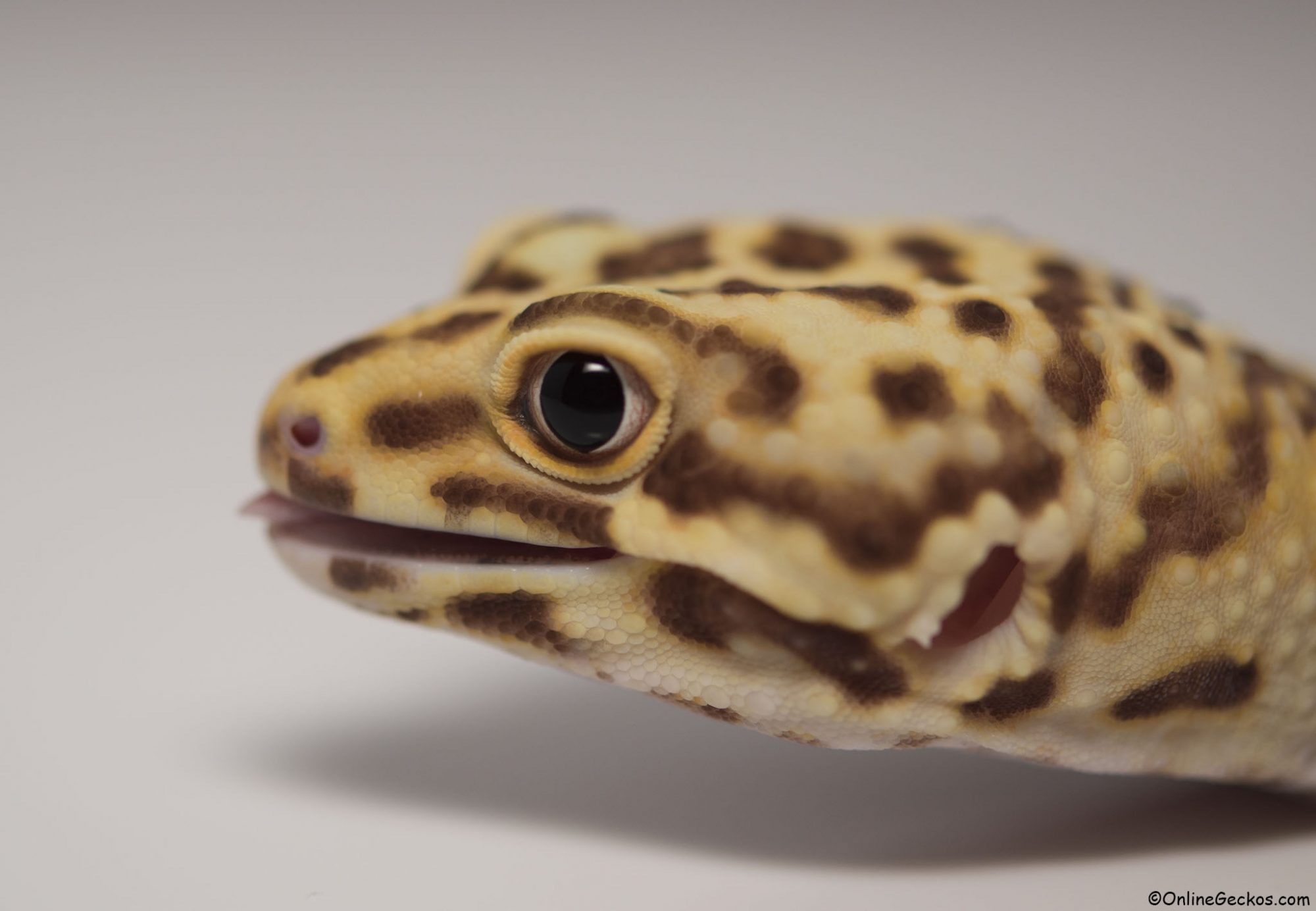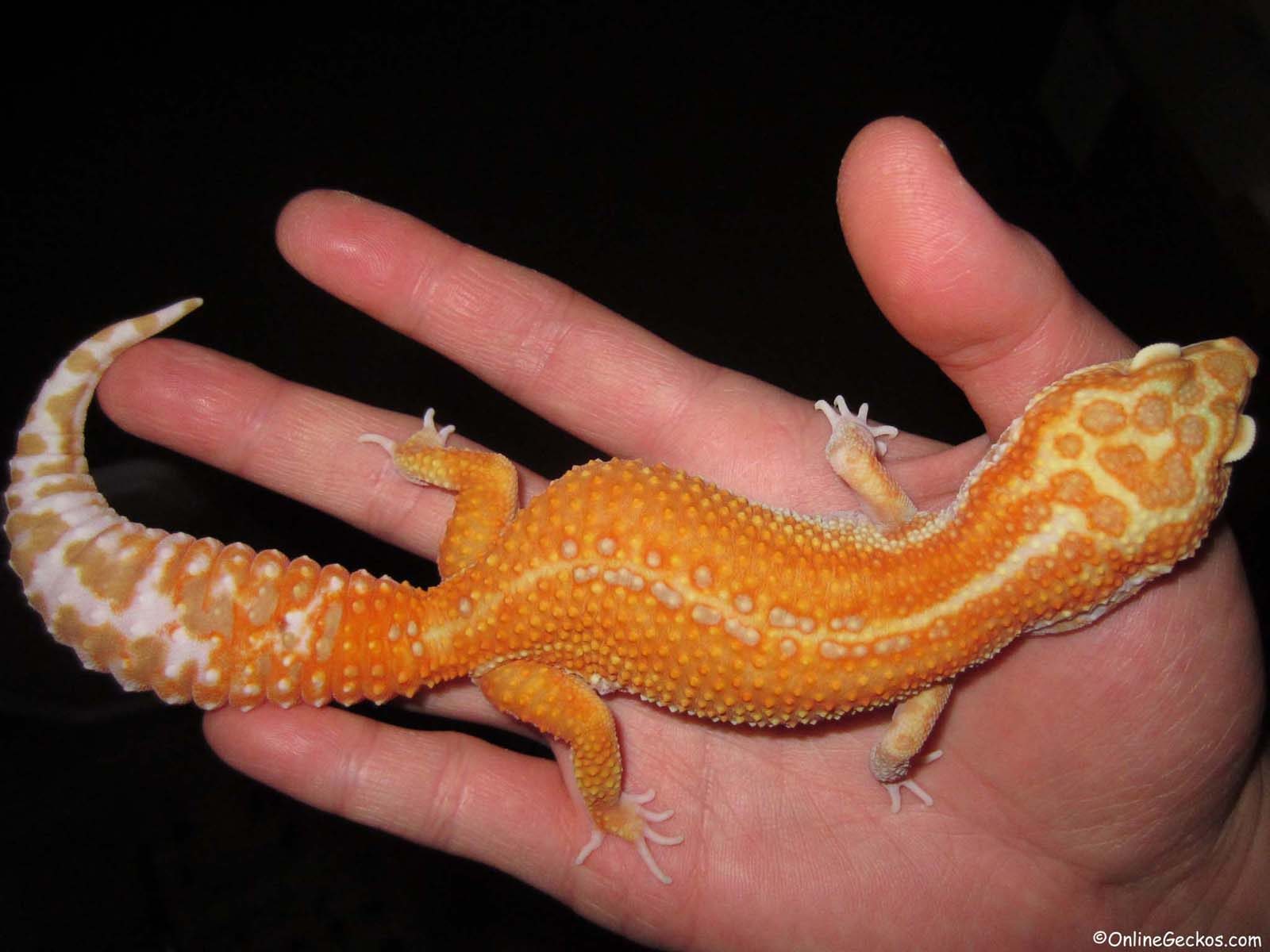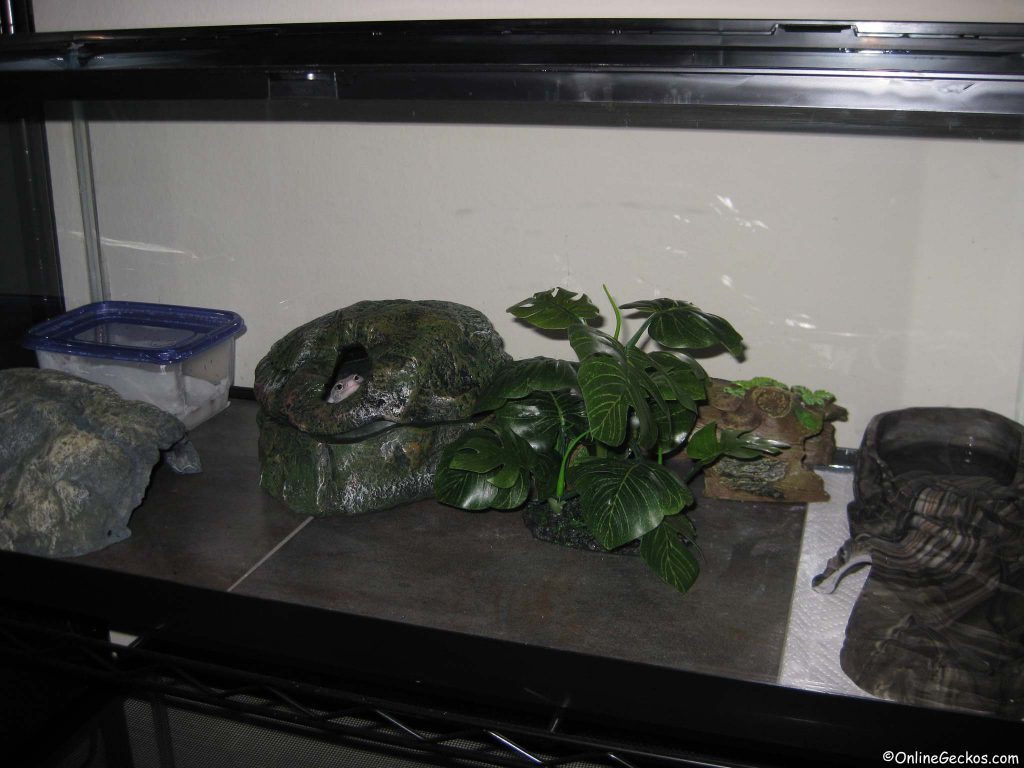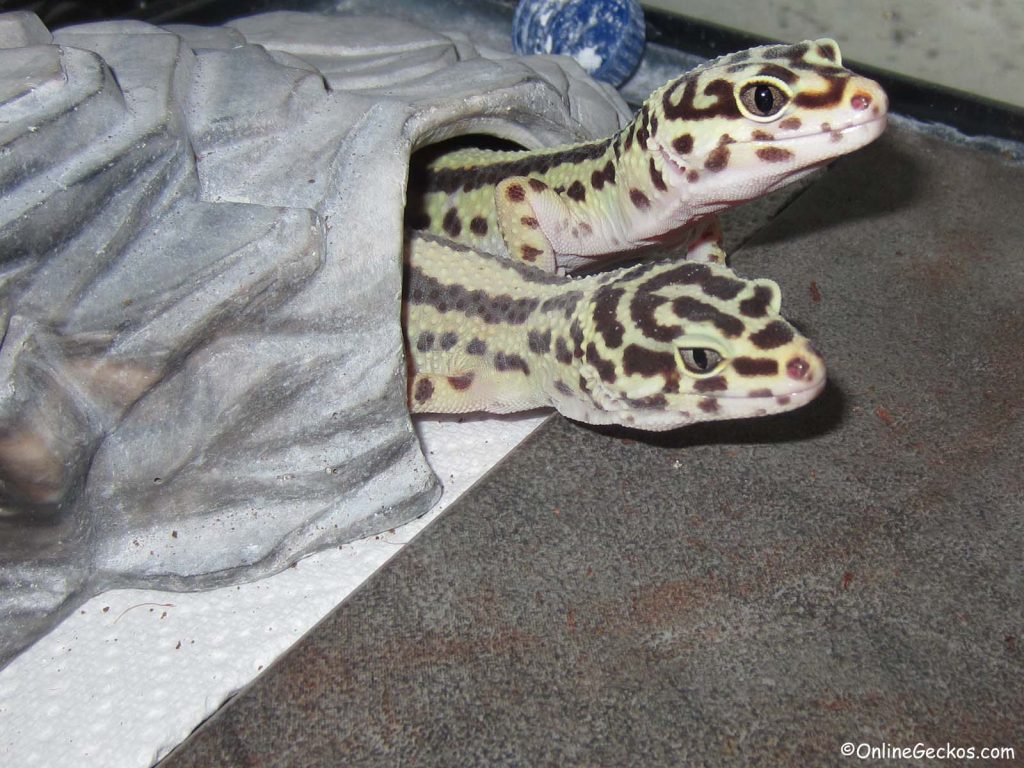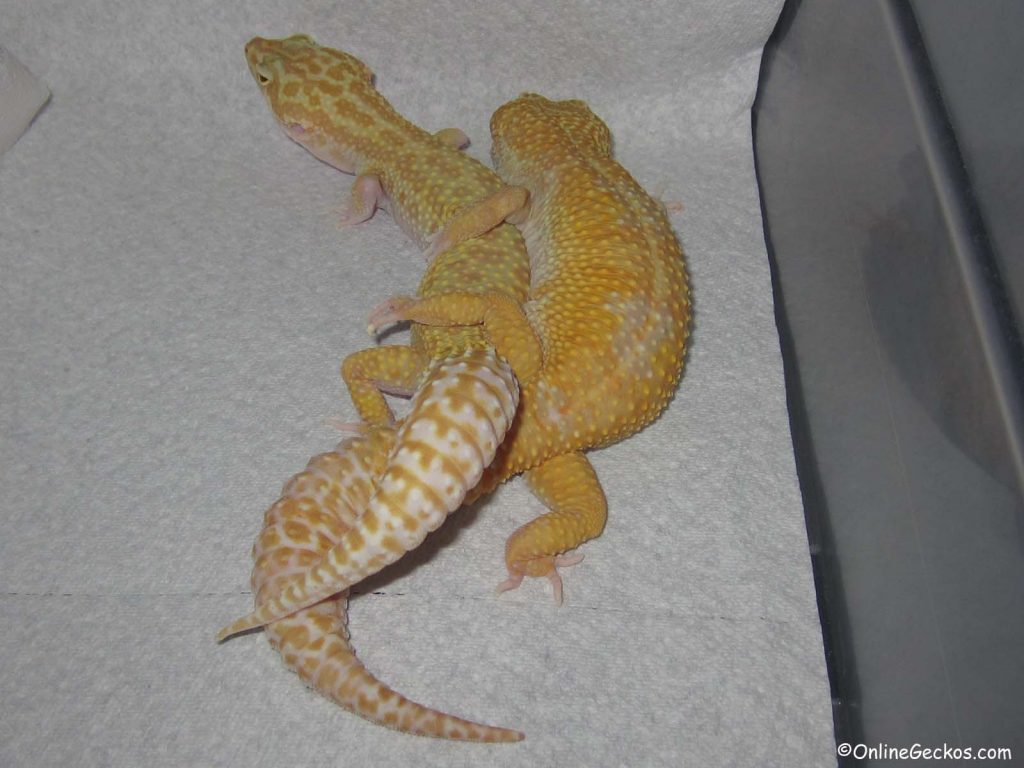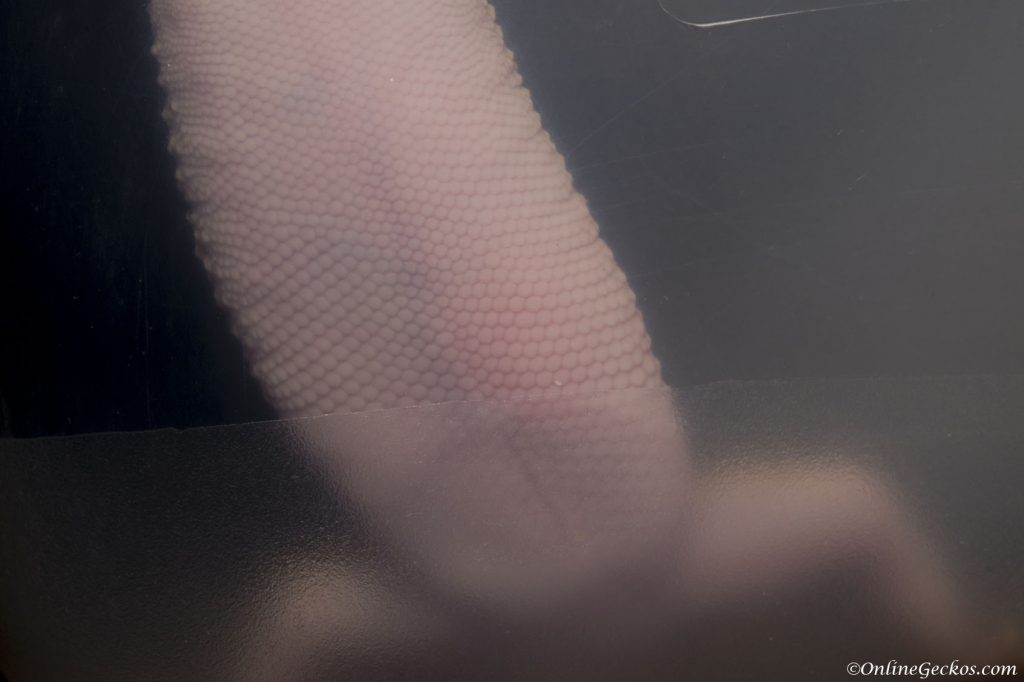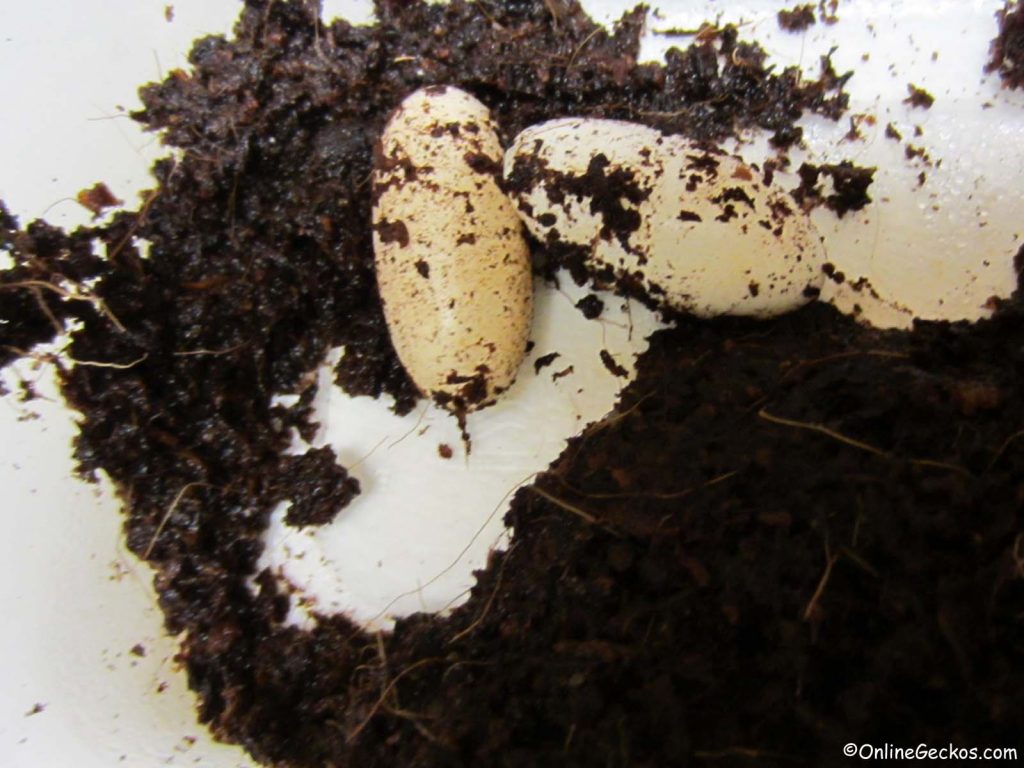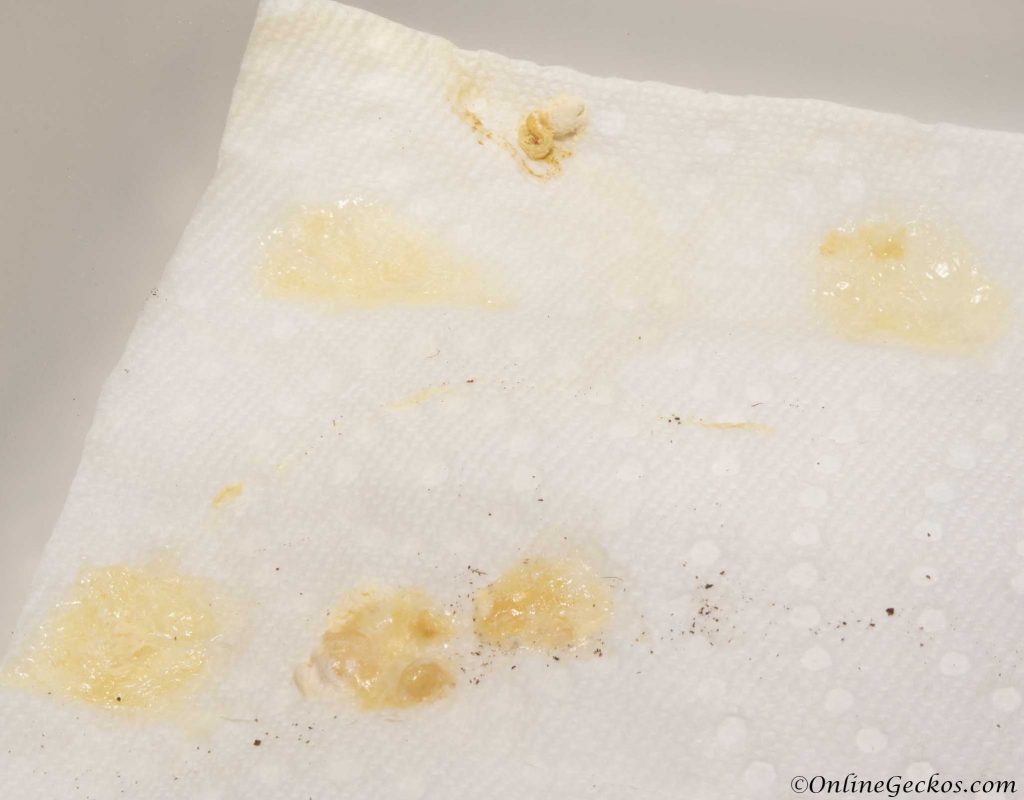One of the most commonly asked questions is “what do I do, my leopard gecko won’t eat”. Your geckos have stopped feeding on a regular schedule, you are now wondering if there’s something wrong. The very first thing you should check is your husbandry. If you have not read our leopard gecko care guide, you should take a look. It contains detailed valuable information on proper husbandry.
Leopard geckos require proper belly heating in order to digest food
If you do not provide proper belly heat, they can’t digest food properly, and could stop eating as a result. The ideal belly heat is between 88 – 93 degrees Fahrenheit. Gecko owners often make the mistake of measuring the air temperature because they purchased a leopard gecko “kit” from the pet store, as they usually come with a stick on thermometer. It’s important you measure the floor temperature where your gecko will be laying on to get the proper temperature reading for belly heat. You can easily and quickly measure your tank’s floor temperature by using a temperature gun like Etekcity’s Digital Laser Infrared Thermometer. Just point and click. Or if you prefer constant reading, a digital thermometer with a probe.
Also some retail kits are known to send you home with basking lights. Remember leopard geckos are crepuscular, they do not bask under sunlight. Basking lights are for diurnal species like iguanas and bearded dragons. It’s important you have an under tank heating pad like Zoo Med ReptiTherm to provide proper belly heating for your leopard geckos.
Click here for our full comprehensive guide on leopard gecko heating and temperature needs.
As part of good husbandry, you should have a warm hide, a cool hide, and a moist hide somewhere in the middle. When you don’t provide proper hides, your gecko could feel stressed and scared. When they get stressed they may stop eating completely. Hides should be snuggly, tight fitting hides where they can feel safe. Leopard geckos do not enjoy hides with big openings with multiple entrances where sunlight/room light can shine in 24/7.
My leopard gecko won’t eat and I use sand or other loose substrate
If you use sand or other loose substrate such as bark, cypress mulch, calcium sand, coarse coconut fiber, moss, walnut shell, and more, there’s a good chance your leopard gecko is impacted. Impaction can occur when the gecko’s digestive tract is blocked by terrarium bedding. This condition can be fatal.
It often starts with your leopard gecko stop feeding on a regular schedule. Then the gecko will stop defecating, and slowly becoming lethargic. Sometimes swelling can be seem on gecko’s belly. Home remedy include soaking your gecko in lukewarm water with a drop of olive oil. If the condition does not improve and your gecko still can’t defecate, then the gecko will require vet care.
Loose substrate should be avoided no matter the age and size of the gecko. Some loose substrate such as bark and walnut shells can actually tear the insides of your gecko, causing internal bleeding. Internal bleeding can be seen as dark coloration on your gecko’s belly. Calcium sand are notorious for causing leopard gecko impaction because your gecko will ingest the sand thinking it’s calcium powder.
Proper terrarium substrate should be slate/ceramic tiles or paper towels. You can even line your terrarium floor with your own rock formation, just make sure the rocks don’t have sharp edges. Leopard geckos are arid creatures, in the wild they live in rock crevices and burrows. Tiles are very comfortable and natural to them. Repti-carpet is passable but not ideal.
While repti-carpet does not pose impaction risk, the little loops in the carpet will cause your gecko’s toes, mouth, and teeth to get stuck at times. This is likely the first thing you will notice. Repti-carpet is also hard to clean, they trap bacteria. To clean them properly you’ll have to take the whole thing out, wash them, and air dry them. Where as with slate/ceramic tiles, you can just spot clean. Paper towels you just replace.
Eco Earth Coconut Fiber for ideal laybox/moist-hide substrate
We do recommend Eco Earth coconut fiber for moist-hide and laybox substrate. There’s a big difference between using coconut fiber as moist-hide/laybox substrate as opposed to having the whole terrarium floor be covered with loose substrate. And no we don’t recommend using coconut fiber to cover the whole terrarium floor either, as the humidity level will become too high inside the tank. High persistent humidity can cause upper respiratory infection.
Be safe, don’t chance with your leopard gecko’s lives. For every person that states they have housed leopard geckos successfully on loose substrate, there’s an opposite, sad tale of someone losing a leopard gecko due to impaction. This is why retail “kits” are dangerous, as they often send first time hobbyists home with loose substrate and basking lights. Neither of which are ideal for leopard geckos.
What if my husbandry is good and still leopard gecko won’t eat? Look for changes to their living environment
It’s important to note if you’ve moved items around in their environment, or rehomed them recently, they could also stop eating. Being placed in a completely new living environment is a big deal to them. Leopard geckos are big on territory, they need to know where they’re living in is safe and familiar. When you replace their hides and items, or rehome them completely to a new tank/location, or perhaps you just received your new gecko from a breeder, it will take them awhile to get accustomed to their new living environment. It could take days or even weeks before they get settled in.
Not only do they have to get used to new temperature & humidity if they just got relocated, they have to get used to living in a completely new environment without their scent. Leopard geckos mark their scent by dragging their tail base around the tank. They won’t feel at home until their scent is everywhere.
In this situation, the best thing to do is to fill their feeding dish with mealworms/superworms/dubia roaches, then just leave them alone for a few days. Make sure they have fresh water, and just leave them to settle in. They’re cute and irresistible, you want to handle them and play with them. But the quicker they can feel safe, the faster they will settle in, and the sooner they’ll d start eating again.
My Leopard Gecko Won’t Eat – Dealing with picky eaters
Assuming your husbandry is good and your geckos are healthy, you just may have a picky eater. We have posted an article with tips on how to get your geckos to feed more. Picky eaters do eat, they just don’t eat much. We highly recommend you to read both articles as they both contain valuable information for gecko hobbyists.
My Gecko Stopped Eating – Feeders and superworms
We’ve seen cases where a gecko was feeding well, but all of a sudden stopped eating because he got bit by a superworm. Yes superworms can bite, so can crickets. If your geckos stop wanting to eat superworms or crickets, you may want to try feeding them a different insect. For a list of good feeder choices for leopard geckos, see our guide on insect feeder nutrition.
It isn’t uncommon for a gecko to refuse the same feeder once the gecko got bit by it. Sometimes they will get over it after awhile. But often they will remember what bit them and will refuse to eat the same feeder insect. We have witnessed a gecko violently regurgitate a superworm out after getting bit by it on the inside. The gecko went on to never touch a superworm again.
So keep in mind if you do feed superworms and crickets, you may need to change up the feeder insects if your geckos stop eating them. Many would assume their geckos are just picky eaters. But sometimes there are reasons why they stopped eating them.
Stress and bullying could cause your geckos to stop eating
If you are housing more than one leopard gecko in the same tank, and one of the geckos stopped eating, you may need to think about separating them. While female leopard geckos generally get along given proper tank size and number of hides available, leopard geckos are solitary creatures. They prefer to live alone, this is how they are in the wild. Male and females may get together for a quick mating session, but they move on right after. Females also don’t stick around after laying eggs to care for their young either.
Key to housing multiple geckos is to make sure they are similar in size and temperament. If you have one gecko that is much larger than the other, the larger gecko might bully the smaller one. Although sometimes it’s the reverse, if you have a feisty smaller female, the feisty female will bite and chase the other more docile gecko around. Any type of aggressive and bullying behavior will cause stress to your geckos. When geckos are stressed, they could stop eating as a result.
It’s important for you to observe your geckos and watch for bullying behaviors especially during feed time. They can look docile when they’re just resting. But during feed time they may get aggressive or competitive over food. If you see this happening, you best start building a new tank and separate your geckos. There really isn’t a way to train your geckos to get along, they aren’t like dogs & cats. They don’t do tricks and you can’t train them to sit. Leopard geckos operate on basic instincts; they are territorial, and they care about their food.
Keep male & female separate
If you are housing a male and female together, it’s generally a bad idea because the male will attempt to mate with the female more than the female would like to. This causes more stress because the female will be forced to run & hide, and often this ends up in fights. A stressed female forced to hide from the male is almost guaranteed to stop feeding. We recommend housing male and females separately for their well-being.
My leopard gecko won’t eat despite good husbandry and no changes to environment, now what?
Another reason your leopard gecko could stop eating is that they are sick or have parasites. Don’t be too alarmed just yet, there are signs to look out for to determine if they are indeed sick. You will want to start tracking your gecko’s weight, as a sick gecko will likely lose weight rapidly. You can track your gecko’s weight with a weight scale like Ozeri Pronto Digital Scale. We are talking about 5-10g a week kind of rapid weight loss. If your leopard gecko is losing weight rapidly, you should immediately take your gecko to a reptile vet.
One thing the vet will ask you for is their fecal sample. So collect some fresh samples of your gecko’s feces to bring along with you to the vet. Watery stools is a sign of possible parasites. Doing a fecal exam will determine if your gecko has parasites. Rapid weight loss and a fast shrinking tail, with possible tail loss, are also signs of parasites or diseases.
Some vet clinics will allow you to request a fecal float without a full examination. If you have a relatively healthy leopard gecko, but you have doubts about your gecko possibly being infected with parasites, you can take a fecal sample in to your vet clinic and do a fecal flotation. This is a cheap and quick way to find out if your leopard gecko is infected with parasites.
Another sign your gecko is sick is if your gecko is shedding excessively, and having bad sheds
Leopard geckos will shed normally by themselves every once in awhile. Young geckos shed often, usually once a week or two. This is because they are constantly growing. Adult geckos shed less frequently, usually once every month or so. By providing a moist-hide, you will ensure your geckos can successfully shed on their own.
It’s normal for your leopard gecko to stop eating a few days before they shed, as well as a few days after they shed. If you’ve watched their shedding process, they actually eat their own skin. Once they defecate after they shed, their stools usually look a bit yellow. This is normal, so don’t be alarmed when their feces don’t look right after they shed.
Now if they start to shed excessively, multiple times a week, and they appear to be having bad sheds, this is a sign they are sick. You can assist them by bathing them in lukewarm water and help them shed. But if this continues, you will want to take your gecko to a reptile vet.
Bad sheds can be painful to them. Multiple bad sheds one after another could cause a condition in which the geckos become unable to shed the skins on their own. The dry skins will layer on top of each other, constricting the gecko. The sheds dry up and get stuck in their eyes, ears, nose, also sometimes on their toes and tail. Stuck sheds in their eyes can cause blindness, so you have to help them when you notice stuck sheds in their eye. When this happens, one or both of the gecko’s eyes would be stuck shut. Take a moist q-tip and gently rub around the eye and slowly peel the skin off. You can also use a sterile eye saline solution to help loosen the skin in tough situations.
Stuck shed on the toes could cut off the circulation of their toes, causing the toes to eventually fall off. Same with the tail, if the tail is constricted by dry shed for too long, especially when there are multiple layers of it, it could result in tail loss. It is very important for you to assist with your gecko’s bad sheds, do not take it lightly.
The gecko below (our Radar male Kronos) had access to a moist hide, but he still had a rough time shedding one day. He had shed stuck in his eyes and ears. There were also excessive shed stuck on his hind feet and tail. This is one day after he started shedding so if no assistance was given, the skin would’ve hardened and caused him pain.
My husbandry is good, gecko isn’t losing weight or having bad sheds, still my leopard gecko won’t eat. Is there anything else?
If your gecko isn’t losing weight and still not eating, it could be that your gecko is going through puberty. When leopard geckos first reach sexual maturity, their behavior may change. Males could reach sexual maturity as early as 6 months old, while females usually reach sexual maturity at around 8-12 months. You usually would notice your male becoming territorial for the first time, while your female may get a tad more skittish because they are ovulating for the first time. Both male & females could stop eating completely when they first reach sexual maturity, often weeks or months at a time. This is a normal cycle every young leopard gecko goes through.
Spring Fever – Breeding season cycles
Once leopard geckos reach adulthood (1 year old), their bodies will start functioning on a more seasonal schedule. Breeding season usually starts at around January, and it could last until June/July. During these months, your adult leopard geckos could go through breeding heat. Your females will ovulate, your males might get restless and want to come out of the tank all the time. During this time, there’s a good chance your leopard geckos will stop eating. They could stop eating for weeks at a time, sometimes even months.
Your ovulating females will usually only eat in between ovulation cycles. For us breeders, females will eat in between clutches. But they’ll only feed for a few days before they’re ovulating again and back to fasting again. Males during this time usually will eat some here and there, but not much at all. They could go off food for weeks and months at a time as well.
This may be alarming for new leopard gecko owners, but it is all normal. When I first got into leopard geckos I too had doubts about my gecko’s eating habits. Every time one of my geckos stopped eating I would get nervous and stressed. But after a couple of seasons, I learned about their cycles. So for new leopard gecko owners, remember if you have a young gecko, you will experience this when your gecko first reach sexual maturity. Then once they become adults, they will follow a seasonal breeding cycle as described above.
To read more about yearly cycles, click here.
My Leopard Gecko Not Eating – How to tell if my female gecko is ovulating or gravid
When you look at your female leopard gecko’s stomach, you’ll notice pink, oval spots. They can be located as high as their stomach, towards the middle of their abdomen. Or they could be near the lower left and right sides of their abdomen.
Smaller round circles are ovum, they are female reproductive cells waiting to be fertilized. They are usually developed just below their stomach. Then once fertilized, they are slowly moved towards the lower left and right sides of their abdomen. As the eggs develop and grow, they become more elongated. Note that females can develop eggs without a male fertilizing the ovum. We have a new article “Leopard Gecko Ovulation Cycles” that goes into this in more detail.
Here’s an example of what you’ll see:
Should I be concerned if my leopard gecko won’t eat at all during the whole breeding season?
When geckos fast over a breeding season, they will lose weight. But it won’t be rapid weight loss, that’s the key difference. Losing a gram here and there every couple of weeks is normal for them during the breeding season. If your female is laying eggs, she’ll lose more weight over time. Once the breeding season is over, or when your female stops ovulating, they’ll start feasting and eating again. They’ll gain all their weight back and more during the summer & fall. The reason for them to have a plump tail is so they can go through long periods without food. The fat stored inside their tail is used by their body when they are off food.
This is important for new leopard gecko owners to understand because this cycle happens every year, and there’s really nothing to be alarmed over. Breeders know about this cycle, but general hobbyists usually don’t unless they’ve done their research. Since “my leopard gecko won’t eat” happens to be one of the most commonly asked questions, I feel it’s important I put this information out there.
Final words – Egg Binding in Reptiles (Dystocia)
Egg binding is a serious issue. It can happen to female leopard geckos even if they are not being bred. This is because female leopard geckos can develop eggs without copulation. Egg binding is something breeders don’t talk about often. But I feel with such a lack of dialogue, geckos are suffering as a result because hobbyists don’t really know what to look for (or what Dystocia even means).
Dystocia means egg retention. It occurs when females are unable to pass eggs through their reproductive system. Egg binding happens most often to first-time breeders, females carrying infertile eggs, or females who had egg binding issues before (source). Since females can develop infertile eggs without males present, this issue can happen to any female leopard geckos once they’ve reached sexual maturity.
Causes of Leopard Gecko Egg Binding
Female leopard geckos first reach sexual maturity between the age of 8-12 months old. They will ovulate for the first time, and they could develop fertile eggs if bred, or infertile eggs without mating. When females are under 1 year old, sometimes they are not done growing, and their body isn’t developed enough to push large eggs out. Egg binding can occur when their body is under developed, or their muscles aren’t strong enough to push the large eggs out. Dystocia can also occur if the eggs are positioned wrong, or there’s an obstruction preventing eggs from being passed through.
If the female is malnourished, obese, dehydrated, stressed (being housed with other geckos or disturbed often), or if the female was bred too young or too old, all could cause egg binding. Furthermore, the lack of a proper laybox or laybox substrate could cause the female to hold on to the eggs.
Since gravid females will often stop eating, this can be hard to detect. But healthy gravid females should still be alert, active, they should still drink water, pass urates, shed properly, and perform normal daily activities. If you notice your female leopard gecko becoming lethargic, or she starts to shed excessively and having bad sheds. Or if she digs for long periods of time and you can visibly see her straining while raising her tail without passing eggs. These are all signs of her possibly being egg bound.
If you notice the female pass a large amount of creamy mucus substance, this is a sure sign that your leopard gecko is egg-bound. The good news here is that she is passing the egg. The bad news is she’s egg-bound, and there could possibly be more eggs stuck inside her. She needs to be able to pass the content of the eggs or it could cause infections inside her. Picture below shows you what the creamy mucus substance will look like.
What happens is if the eggs are stuck inside her, it could rot or possibly burst. Depending on the position of the eggs, it could cause serious infections and your gecko could die as a result. A healthy female not egg-bound will lay the eggs, fertile or not.
Leopard Gecko Not Eating – Provide A Proper Laybox
If you are lacking a proper laybox using good laybox substrate, you could save your gecko by putting them in right away. A proper laybox should be well hidden, private, tight fitting, and slightly moist. Good examples are Exo Terra Gecko Cave , Zilla Rock Lair, and Zoo Med Reptile Shelter 3-in-1. And Coconut fiber is a great laybox substrate that will work well for gravid females. It doubles well as moist-hide substrate.
Treatment
If no eggs are laid even with proper husbandry while your gecko is exhibiting all the signs of being egg bound, then you should take your leopard gecko in to see a specialized reptile vet. Diagnosis is difficult, but allow the vet to make the call. Treatment for egg bound leopard geckos include physical manipulation, aspiration, and surgery.
Prevention
Proper husbandry and nutrition are keys to preventing dystocia. You should also be mindful of the age and physical condition of the females before breeding them. Be a responsible and ethical breeder, don’t breed a female if she’s too young, too old, malnourished, not feeding well during offseason, or if she had prior egg binding issues. Obese geckos are known to have difficulties passing eggs, it’s important to not over feed your leopard geckos. You should put the geckos on a better, low fat diet. See our guide on feeder insects.
We hope this article has been helpful. It’s a long article, but there many reasons why a leopard gecko won’t eat. We tried to touch on as many causes as possible. This article will be updated when we gather new information to share. As always, if you have any doubts, ask. There are many experienced and knowledgeable individuals that could help you solve these mysteries.
